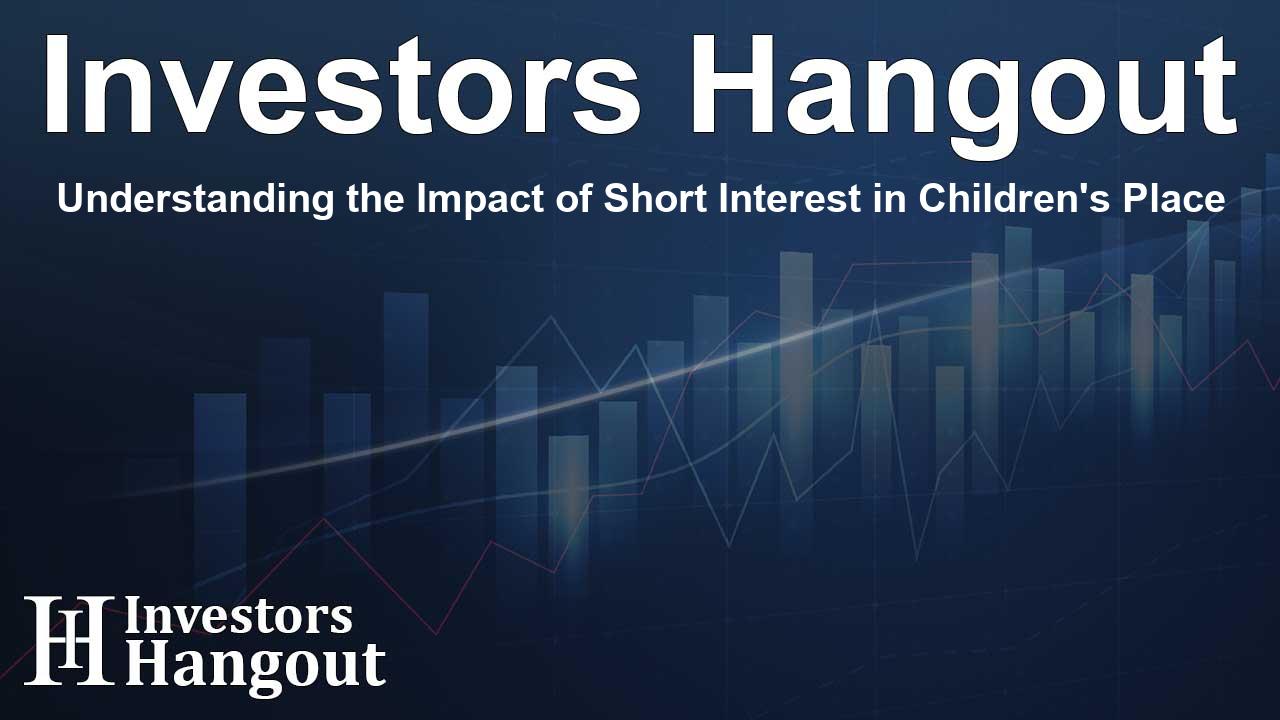Understanding the Impact of Short Interest in Children's Place

Short Interest Overview of Children's Place
Children's Place (PLCE) has seen an increase in its short percent of float, rising to 26.48% since the last report. The company disclosed that it has 2.82 million shares sold short, which accounts for 53.78% of all regular shares available for trading. Considering the trading volume, it would take traders approximately 9.27 days on average to cover their short positions. This growing trend in short interest has significant implications for investor sentiment and market dynamics.
Why Monitoring Short Interest Is Crucial
The Basics of Short Selling
To understand why short interest matters, it is essential to know what short selling entails. This action involves investors selling shares of a stock they do not possess with the expectation that the stock's price will drop. If they are correct and the price decreases, they can repurchase those shares at a lower price for a profit. However, if the price rises, they face potential losses.
Market Sentiment Reflection
Short interest serves as a critical barometer of investor sentiment regarding a particular stock. An increase in short interest often indicates that investors are increasingly bearish, anticipating a decline in stock value. Conversely, a reduction in short interest can suggest growing bullish sentiment. For Children's Place, the rise in short interest warrants attention as it could signal shifting perspectives among traders.
Recent Trends in Children's Place Short Interest
Three-Month Trend Analysis
The data indicates that the percentage of shares sold short for Children's Place has progressively increased since the last report. While this rise does not necessarily predict an imminent price fall, it is vital for traders to stay informed about the heightened short activity.
Understanding Market Dynamics
As the market shifts, tracking short interest reveals valuable insights. Investors should consider whether the increasing short interest could lead to a short squeeze, a scenario where a stock's price unexpectedly spikes due to aggressive buying. Such occurrences can present lucrative opportunities for traders who observe patterns in short selling.
Peer Comparison: Looking Beyond
Benchmarking Against Competitors
When assessing Children's Place, comparing it with peers can provide a more comprehensive view of its performance in the market. Companies similar in size, sector, and financial standing form a peer group that investors often utilize for comparative analysis. According to recent data, Children's Place's peer group averages a short interest of 12.24%, indicating that Children's Place has significantly higher short interest than most competitors.
Potential Bullish Indicators
Interestingly, increasing short interest may not always translate to negative outcomes. In some situations, it can indeed serve as a bullish signal indicating potential buying opportunities. Investors should remain vigilant to identify such scenarios, staying updated on market trends and shifts in trading behavior.
Wrap-Up on Children's Place Short Interest
The Importance of Staying Informed
For investors in Children's Place (PLCE), understanding the implications of short interest is crucial. Analyzing trading volumes, peer comparisons, and market sentiment can equip investors with the insights needed to make informed decisions. In an environment where market dynamics are constantly evolving, being proactive is key to navigating potential risks and opportunities. Always track these developments closely to strategize effectively.
Frequently Asked Questions
What does short interest mean?
Short interest represents the total number of shares sold short that have not yet been covered or closed out. It helps gauge investor sentiment.
How does short selling work?
Short selling involves borrowing shares to sell them, with the intention of repurchasing them later at a lower price to profit from the price difference.
Why is the rise in short interest significant?
An increase in short interest may indicate a prevailing bearish sentiment among investors, suggesting a potential decline in the stock's price.
How do I analyze short interest effectively?
To analyze short interest, monitor its changes over time, consider the trading volume, and compare it against industry peers for broader context.
Can high short interest be a bullish sign?
Yes, high short interest can sometimes indicate potential short squeeze opportunities, where investors may rush to buy, driving the price up.
About The Author
Contact Addison Perry privately here. Or send an email with ATTN: Addison Perry as the subject to contact@investorshangout.com.
About Investors Hangout
Investors Hangout is a leading online stock forum for financial discussion and learning, offering a wide range of free tools and resources. It draws in traders of all levels, who exchange market knowledge, investigate trading tactics, and keep an eye on industry developments in real time. Featuring financial articles, stock message boards, quotes, charts, company profiles, and live news updates. Through cooperative learning and a wealth of informational resources, it helps users from novices creating their first portfolios to experts honing their techniques. Join Investors Hangout today: https://investorshangout.com/
The content of this article is based on factual, publicly available information and does not represent legal, financial, or investment advice. Investors Hangout does not offer financial advice, and the author is not a licensed financial advisor. Consult a qualified advisor before making any financial or investment decisions based on this article. This article should not be considered advice to purchase, sell, or hold any securities or other investments. If any of the material provided here is inaccurate, please contact us for corrections.
